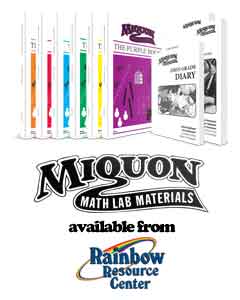About the Author, Lore Rasmussen
Born in Germany,?Lore May Rasmussen?completed her graduate studies
in education at the University of Illinois where she met her husband, Donald.
Mrs. Rasmussen was Assistant Professor of Elementary Education at Talladega College, Research Associate with the University of Illinois Arithmetic Project, and Visiting Associate Professor of Education at Temple University. She developed the Miquon Math Lab Materials during her eight years as teacher and math specialist at the Miquon School, Miquon, Pennsylvania.
During her life, Mrs. Rasmussen served as math workshop leader and speaker for numerous school districts, universities, and professional organizations. In 1976, she was presented the John Patterson Award for Excellence in Education by the Philadelphia Citizens? Committee on Public Education for her work as director of the Learning Centers Project of the Philadelphia Public Schools.
“At the base of Lore Rasmussen’s system is the understanding of a child’s mind. ‘In a small child, mathematical intuition is often far more advanced than his language to express it,’ she says. ‘A child can solve a problem far earlier and with greater speed than his flow of words allows.'”
– From a 1961 Reader’s Digest article by James Stewart-Gordon
Lore May was born in Lampertheim-am-Rhein in 1920, and grew up in German nationalistic schools. Her family was Jewish; after Hitler’s rise to power in 1933 life became difficult with her active opposition to the social injustices of the Nazi Party. To avoid endangering her family, Lore escaped to the United States in 1938. She pursued further education and eventually found herself at the University of Illinois, where she met and married Don Rasmussen — one of her professors — in 1940.
In 1955, the Rasmussens moved to Miquon, PA, where Don began work as principle of Miquon School. Lore wound up as a remedial math teacher. Wishing to change the connotations of being in a “remedial math class,” she went to work finding better ways to teach the children and help them truly understand mathematical concepts. Tactile elements were incorporated, such as folding squares into shapes, and using geometric solids. Eventually, a full math lab was created at Miquon School, where Lore taught in unique ways and allowed exploration of math concepts at children’s will. During one year, her assistant kept a record of all that she did, and this was eventually published as the First-Grade Diary.
The results she was achieving amazed many people. Reader’s Digest produced an article on her work — and it quickly became their most popular article up to that time. She presented at the University of Illinois and the National Council of Teachers of Mathematics (NCTM)… All this without having any formal training in mathematics beyond high school.
In 1963, the Rasmussens left Miquon and began working with schools in downstate Pennsylvania, helping impoverished and struggling students grasp concepts and learning skills. Lore was instrumental in helping establish the Durham Child Development Center in South Philadelphia. In 1976, she was awarded the John B. Patterson Award for Excellence in Education, and in 2003 Talladega College awarded her an honorary doctorate. Lore Rasmussen died on January 23, 2009, at her home in Berkeley, CA.
Rainbow Resource Center
Interested in more homeschool/educational resources and helpful information?





